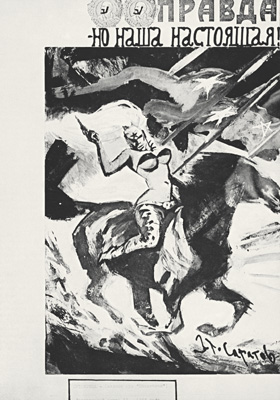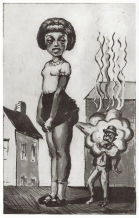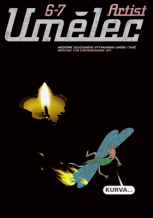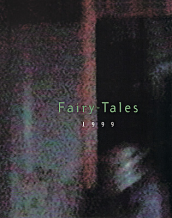| Zeitschrift Umělec 2002/3 >> Octobriana a ruský underground, part 1. | Übersicht aller Ausgaben | ||||||||||||
|
|||||||||||||
Octobriana a ruský underground, part 1.Zeitschrift Umělec 2002/301.03.2002 Tomáš Pospiszyl | focus | en cs |
|||||||||||||
|
"The most mysterious character of international comics
was invented by a Czech 35 years ago Stunning Mystification — A Bitter Cold-War Document — A Living Legend Octobriana is a female warrior with a red star on her forehead and light hair tied high up into a ponytail. A tiny scarf covers her enormous breasts. Her eyebrows have grown into one solid patch and Negroid or Asian features dominate her face. These features are perhaps only the physical expression of her animal sensuality. She comes from Soviet Russia to fight for liberation of the oppressed. Many readers of these lines have certainly wondered why, with a few exceptions, Czech culture lacks a strong tradition of comic literature. True, we have Fast Arrows, Kája Saudek and Revolt of the Brains. However, these examples are very different from one another, suggesting that, unlike in American culture, we cannot talk of a continent of comics here but rather of several isolated islands. Due partly to historical circumstances that had nothing to do with art, the Czech lands have never really created graphic novels. The 1940s installed Nazi censorship and the 1950s brought the censorship of socialist realism. Despite the waves of Nazi censorship in the 1940s and the guiding fist of socialist realism in the 1950s, Czechoslovakia produced several excellent illustrators working in adventure literature; sadly, these artists completely missed the development of international comic books. It is hard to say why these censors focused on the seemingly innocent comics, a form without lofty ambitions, serving only for immediate entertainment. Perhaps they guessed at political possibilities in comics and their latent anti-totalitarian character. In America, the purely commercial comic craft became an art discipline thanks to the capabilities and ambitions of a few artists. Analyses have revealed that seemingly apolitical comics reflected political situations and often commented sharply on hot social issues. Comics became the battlefields of the two super powers during the Cold War. Entertainment literature found itself in a strange situation in post-war Czechoslovakia. So-called “decadent” literature like penny-dreadfuls, cheap detective stories and adventure novels were systematically eradicated within a few years. The comic format was also unacceptable. If someone wanted to make a comic story, he or she had to smuggle it, more or less, into the media. Comics could be used, as was often the case, as an example of decadent —but undeniably entertaining — Western culture; in the eyes of Czech illustrators, the Western pathos and naivete confronted the boring and un-Superman-like life of local heroes. Comics in Czechoslovakia were burdened by requirements that basically complicated the birth of the genre. It had no chance to relate to any existent mass culture. Ultimately, the only refuge for Czech comics was the world of unimaginative children’s magazines. The following story describes one attempt at making world-famous comics in Czechoslovakia. The project failed for a number of reasons, but it became a clear example of the possibilities and antagonisms in Cold War culture. It is not a story of good scripts, drawing styles and dividing the picture story into individual image fields. It is rather evidence of how much a comic character is able to bear and what incredible transformations a character may go through to allow the author to embrace the absurdity of his time and cope with his own half-genius, half-pathological character. The Book That Shook the Comic World When London-based publisher Tom Stacey first printed Octobriana and the Russian Underground in 1971, the book caused an unusual sensation. It was unusual in the sense that it attracted the attention of not only comic literature readers but also the public around the world. The book presented excerpts from comics made by an underground group of Russian dissident artists who formed a mysterious organization called Progressive Political Pornography. In a miraculous coincidence, a part of their production was smuggled out of the Soviet Union by Czechoslovak citizen Petr Sadecký who emigrated with the body of the comics to the West in 1967. The comics themselves, or what was left of them, occupied only a part of the book. Sadecký’s extensive text began with a tour of Soviet dissident culture informing the reader of the tradition and history of samizdat literature. Long autobiographical parts described his life story when he came into contact with the Progressive Political Pornography (PPP) group as a student of the Prague film school FAMU and a guest lecturer at a university in Kiev. He described PPP’s structure and the birth of the character of Octobriana and laid out his own political views and their development. An extensive part of the book talked about cinema of the Transcarpathian states of the USSR, socialist realism, and the author’s family background in Prague and adventurous trips to Central Asia in the service of Soviet Army General Rodimtsev. On the occasion of the book’s release, articles about the book began popping up in a number of newspapers and magazines. The Daily Telegraph Magazine placed the book on its front page and gave it wide coverage even before it came out. It was followed by a story in the Sunday Times and other articles appeared in the media in Great Britain, France, Italy and other European countries. The discovery of Eastern European political comics came as such a surprise that the book received attention usually reserved for serious literature and political issues. In essence, Octobriana was both. Articles appeared not only in Western newspapers and magazines but, thanks to the book’s explosive political content, also behind the seemingly impervious Iron Curtain. It took merely one week from the time the book hit the shelves until Petr Sadecký’s story was cast in doubt. As it turned out, the public was presented with one of the most remarkable literary mystifications of that time. Viewed from today’s perspective the book perfectly reflected the absurdity of the politically, ideologically and culturally divided Cold War world. Octobriana’s author, or should we say authors, unknowingly managed to successfully portray its antagonisms and oddity. That which was clear to readers from Eastern Europe after a quick flip through the book soon became evident to everybody. Sadecký’s contribution to the birth of Octobriana was far greater than just transporting the hot material from the Soviet Union to the West. Still, as we will learn later, we cannot consider him the only author of the remarkable comic story. The affair was also an example of an unusual art theft, unprecedented in modern Czech history. But even more than 30 years after the book was first published we still lack all the details and the entire truth of the case. This is due to the paranoid situation of the divided world and of Petr Sadecký, the great mystifier and no less paranoid author of the Octobriana concept. What we have today is Octobriana itself and its legend, which in many views turned out to be perfectly orchestrated and remarkably viable. Paradoxically, this comic character remains essentially unknown in the country of its origin, the Czech Republic. 178 Pages of Mystification and Adventure The original British edition of Octobriana is a rectangular format hard cover. The appealing cover shows a color painting of Octobriana whose pose suggests the position of the female Kolkhoz farmer in the famous monument made by Vera Mukhina for the world exhibition in Paris in 1937. The book’s foreword was written by the Russian author Anatoly Kuznyetsov, who had once traveled with Soviet writers to London and decided to stay in Great Britain for good. His text did not concern the comic directly. It described the situation in Soviet culture and politics at the end of the 1960s. Photographs of Boris Pasternak and handwritten texts, which were not officially published in the Soviet Union, come as quite a surprise following the enticing cover of half-naked Octobriana. Finally, readers get an extensive text by Sadecký with rich visual material and excerpts from the actual comic Octobriana. Sadecký describes his first visit to Kiev in 1961 when he was a devout admirer of the Soviet Union. He was invited to give a lecture on Western entertainment literature at a local university. Thanks to an unexpected power failure during his presentation, he branched into an originally unintended explanation of the history of comics. Needless to say, young Sadecký loved comics. He did not perceive the genre as being purely decadent, but realized its artistic potential and relation to other cultural forms. He described this art form to the darkened audience of Kiev students as a typical product of modern civilization that enabled the reader psychological relaxation and an opportunity to overcome Kafkaesque estrangement. He also explained parallels between a comic story and film. After the lecture, a mysterious man who introduced himself as Gerasimov addressed Sadecký. That same night Gerasimov took Sadecký to a secret meeting of a group of young people. The basement clubroom was decorated with a mixture of posters of Lenin and piles of pornographic magazines. Surprised and a bit shocked at first, Sadecký found himself at a meeting of a secret organization called Progressive Political Pornography. He discovered that the group members indulged in sexual orgies and production of strange illegal comics starring Octobriana. PPP contacted Sadecký because they perceived him as a source of information on Western comics, which were almost unknown in the Soviet Union. They hoped that with the help of Sadecký the group would make an end to its seclusion from the outside world. Sadecký did not hesitate and became a PPP member, taking part in wild alcohol- and sex-inspired meetings, documented in the book in the form of blurry black and white photographs. According to Sadecký, the meetings also included projections of the first illegal experimental film in the Soviet Union, in which an ugly girl undressed under a poster of Lenin and urinated on the floor. Sadecký also provided some information on PPP’s historical background. The organization was established in 1957 when Nikita Khrushtchev was in power and the political situation in the country eased. The youth who originally believed in the ideals of communism were politically disillusioned and became cynical dissidents. Allegedly, PPP’s membership numbered 125 in the 1960s with local organizations in USSR’s individual federal republics. Despite the members’ libertarianism and latent anarchism, the organization had a complex and rigid system of confidentiality and communication, exact rules and an ethical codex. The individual local organizations did not know of one another and only special agents distributed the samizdat magazines. Sadecký’s Kiev branch published a magazine called Mtsyry. PPP’s most important mission, however, was their teamwork and almost scientific research on comics about Octobriana. Mysterious Organization According to Sadecký, PPP was comprised of a remarkable mix of members. They were mostly young graduates with bizarre life stories. In the book Sadecký mentions, among others, the Jew Igor, an unconscious existentialist full of disillusion; Ivas, a carpenter, truck driver and librarian at the Karelia Academy of Sciences; and a former crook called Toad. Lydia Borisovna Gal, allegedly adopted daughter of one of the top Soviet leaders Anastas Mikoyan, had a special position within the Kiev PPP cell. The 20-year-old Gal, a bisexual with S&M tendencies, significantly influenced PPP and Sadecký’s orientation. He writes that she dressed in leather but, at some PPP meetings, she came naked except for tall leather boots. She searched out unusual perversions, claiming she was the Marquis de Sade of the Communist era. Sadecký offers a number of hot details from Lydia Borisovna Gal’s sex life: She menstruated from the age of nine when she also started masturbating. From the age of 15 she studied a number of languages and soon spoke fluent English, French, Italian, Portuguese, Persian and Polish. She wrote studies on Aleksandr Solzhenitsyn and witchcraft. Her favorite authors included Sade and the symbolist anarchist Octave Mirbeau. Lydia Borisovna Gal studied medicine for two years to master the knowledge necessary to torture in various ways more efficiently. Within PPP she organized “experimental orgies,” which later served as material for her pornographic texts, some of which describe driving a stake through a person, torturing pregnant women, having intercourse with a tiger and masturbating using the horns of extinct lizards. According to Sadecký, Gal was sent to a psychiatric hospital in 1965 with no chance she would ever be released to live a normal life again. For this reason, he did not hesitate to state her full name in the book. Although Octobriana is a collective work, Lydia Borisovna Gal was her real literary mother. The character of Octobriana was not a figure made up over night. PPP members found her manifestations also in the past, in various cultures and various locations. The genealogy of this comic character dates back to wild women, witches and she-devils. She was a Mayan goddess and Japanese demon, a being that allegedly appeared in the mythologies of all nations. The life of Octobriana is a quest for sexual satisfaction, which is interrupted at its very beginning by the sadistic murder of her lover. The heroine sets out on a path of violence and murder. However, such a life hurls her into black depressions, and she attempts suicide by leaping into a volcanic crater. Instead of death, she finds rebirth in the radioactive flames and becomes a superwoman that will help humanity. But she is once again betrayed by her uncontrollable sexual desire. Octobriana falls in love with another man and the entire cycle repeats itself endlessly. In addition to its mythological features Octobriana also represented “the real spirit of the Great October Socialist Revolution.” This rather surprising twist is owed to the fact that PPP members both loved mythclad sexual perversions and deep down they maintained their belief in the rightness of communism, which had merely been diverted after Lenin’s death. Thus, Octobriana was also a political figure. In many of her stories, she becomes an agent of the Pentagon or Maoists from Beijing. She teams up with anybody who fights against the fossil and anti-humanistic policies of the Kremlin. The book presents two Octobriana stories: “The Living Sphinx from the Radioactive Kamchatka Volcano” (1934), and “Octobriana and the Nuclear Sons of Chairman Mao.” Sadecký claimed that he often visited the Soviet Union and kept in regular contact with PPP. In the mid-1960s, PPP asked Sadecký to take selected Octobriana comic stories to the West and publish them. Sadecký spent several months traveling in the Soviet Union collecting material and storing it in Prague. In 1967, he escaped to Germany with a trunk full of images. In a short epilogue, Sadecký predicts that the KGB will try to claim that the book is a counterfeit and an effort by the CIA to discredit the Soviet Union. To a certain extent, this came true, but doubts about the book’s authenticity appeared outside the Soviet secret services. First Cracks Doubts about Octobriana’s authenticity came as no surprise. A detailed look with even minimal knowledge of conditions in the USSR showed a number of facts that could hardly pass serious criticism. The magazine Newsweek even claimed that the book was a counterfeit released by the KGB to discredit dissident culture with such an unlikely work. Internationally acclaimed author Anatoly Kuznyetsov tried to support the book’s authenticity in his foreword. Although he wrote that he never came into contact with PPP during his life in the Soviet Union, he recalled a number of groups based on similar principles. In a country where cities are full of prostitutes, homosexuals, lesbians and homemade pornography, Kuznyetsov confirmed the existence of similar nonintellectual and apolitical samizdat intended for mass consumption. According to Kuznyetsov, the photographs of PPP meetings were also authentic. Closer observation, however, revealed that anybody could have taken the pictures anywhere with the help of a few friends. All one needed was a few copies of the Soviet newspaper Pravda, several fur coats, Russian icons and pictures of Stalin, as these were the only elements suggesting a Soviet environment. The average reader does not quite understand why dissident circles in the Soviet Union would indulge in creating an unlikely comic book heroine fighting for a happier tomorrow and the true legacy of the October Revolution. Sadecký’s explanation that Octobriana was a sublimation of everything Soviet citizens lacked did not sound very convincing. Instead the peculiar community surrounding Octobriana and Lydia Borisovna Gal’s stories are like some bad pornographic literature with their fantastic plots, black and white characters typical of American comics and secondrate adventure literature. Furthermore, one does feel the contrast between the stated political background of Octobriana’s stories and the actual comic stories published in the book. The first one is a sequence of images portraying Octobriana’s fight with a strange creature somewhere near Kamchatka, where a flying ball with magical qualities has taken her and her friends. The second fragment of the comic is a dramatic riding scene which takes place somewhere in Mongolia, where local herdsmen are cast as Tibetan partisans. A tussle with a huge radioactive walrus and a ride on a herd of wild yaks is about as close to political and subversive satire as it is to real life. All the political allusions and the alleged sexual escapades of the heroine are found only in Sadecký’s commentaries on exotic landscapes. Sadecký describes something more reminiscent of bad James Bond plots than authentic dissident literature. It is hard to believe there is any political background, real or even metaphorical social jeopardy in gigantic turtles as living tanks, or Octobriana leading an army of Yettis. Her stories fit into the psychedelic atmosphere of the early 1970s rather than the gray reality of the Brezhnev totalitarian regimes. The fragmentary character of the work is also peculiar. This could be ascribed to the fact that Sadecký managed to export only parts of the series. Still, the published parts are in strange contrast to the main political and sexual characteristics of Octobriana, as Sadecký presented them. None of the images has original Russian text, which is either missing completely or the texts are written directly in English. Going against standard comic book policy, some of the bubbles with Russian text were written in on a typewriter and show serious grammatical mistakes. The observant reader could not but help notice that in one of the stories the heroine is addressed as Amazona, not Octobriana. To put all doubts on the table, one must also ponder and finally consider unlikely that in 1961 18-year-old Sadecký was invited to a Kiev university as a scientific authority to give a lecture on something called “Western popular culture.” The life stories of the individual PPP members do not sound likely either. Their activity and rules fulfill rather adolescent romantic ideas of secret organizations. None of the published images directly combines Octobriana with any political facts or names of Soviet leaders of that time. Lenin or the Kremlin towers appear only on some of the worst pictures or obvious collages combining drawings, photographs and cut- outs from Soviet newspapers and magazines. Readers from Czechoslovakia could quite easily recognize the typical drawing style of images, which allegedly formed the covers of the individual Octobriana stories. Undoubtedly it was the style of Zdeněk Burian, a significant personality in Czech adventure literature. Dispute Over Authorship How did Zdeněk Burian become the author of Russian underground comics? It now appears that what happened was unwitting and against his will. At least, this is what he vehemently charged. Doubts over Octobriana’s authenticity appeared in the press immediately after the book was published in Great Britain. Nick Barkow of the West German magazine Stern was the first to react in his article “Political Porn: A Naked Woman Storms the Kremlin.” According to Barkow, the magazine was contacted on the phone by Czech illustrator Bohuslav “Bimba” Konečný who branded the book a forgery and scam, claiming that he and Zdeněk Burian had made the drawings published in it. According to Konečný, Sadecký had asked for thousands of his and Zdeněk Burian’s drawings while living in Prague. Then he left for Germany with them. When the two artists wanted their drawings back, they were told that it was too dangerous because the original illustrations had been done over in a political tone. Stern quoted Zdeněk Burian as saying: “I had already heard in 1969 that Sadecký wanted to alter the stolen paintings into an anti-Soviet work. Furthermore I once saw a drawing of this ‘superwoman’ who was to become Octobriana at my colleague Konečný’s house.” In an article by William Shaw-cross, the Sunday Times continued in a similar tone. Three artists from Prague told international press that they made Octobriana originally as an entirely apolitical heroine of adventure stories and her name was Amazona. (Illustrator Miloš Novák joined Konečný and Burian as one of the authors.) Sadecký responded in a series of unlikely explanations, which advocated the original legend of Octobriana as a creation by Russian dissidents. For security reasons, his friends in Prague took out the political symbols so that it was possible to take the images across the border. Naturally, they gained the illustrators’ style. Once in Germany Sadecký himself drew back the missing parts. However, other inconsistencies began to pop up. Some of the images known from Octobriana appeared in the magazine Figaro Litteraire in 1968 as Sadecký’s original drawings. Octobriana appeared even earlier in Vampirella with a bat on her forehead instead of a star. Sadecký sent it in himself and signed it. I have already mentioned that the heroine was addressed as Amazona in one of the stories. It almost looks as if Sadecký himself left behind various clues, ultimately convicting him of the sham. On 5 December 1971, the magazine Stern got back on the case and tried to unravel the story. The writer gathered all available information. Although he lacked many parts to Sadecký’s version of the story, he claimed that the official tale of the making Octobriana could not pass. According to Stern the only real authors of the comics were Bohumil Konečný and Zdeněk Burian. Illustrator Miloš Novák unknowingly participated in a small story in which helicopters hover over Prague, which Sadecký turned into a scene depicting the 1968 occupation of the city. Mysterious Petr Sadecký Who was Petr Sadecký, the key to the entire story? There are a number of facts about him from various sources. However, it is almost impossible to verify any of it. If the information comes directly from Sadecký, given his ability at mystification, caution is warranted. Petr Sadecký was born on 4 January 1943 in Prague. He claimed to come from the family of a communist school director. He grew up and lived in the Dejvice neighborhood. From a young age Sadecký showed great literary talent. Before he was 17, he was accepted to FAMU film school in Prague to study film theory and science. He attended the school from 1960 until 1964. At that time, FAMU was experiencing its golden era and the school was full of excellent professors and students. A number of Sadecký schoolmates have become successful filmmakers. After several decades today’s 60-year-olds have misty memories of that time, however it appears that Sadecký was hard to miss in FAMU. The appearance of a slender choleric with glasses — similar to Oscar winning director Jiří Menzel — attracted attention. He was different from most of his schoolmates, and he allegedly had no friends among them. Most students perceived him as some kind of Kafka figure, cautiously protecting his secrets and living in a carefully constructed world full of remarkable mystification. Already in school, he was known as a pathological fabricator. It was impossible to know what he meant seriously, what was truth and what was his own construction. “I never saw him smile throughout that period,” recalls documentary filmmaker Milan Pešek. “Nobody really knew how he got through the school.” Sadecký’s ex-schoolmates also included current Prague rabbi Karol Sidon, who is also unable to distinguish between the rumors and reality surrounding Sadecký’s legend. However, he still remembers the projection of Georgian films organized by Sadecký at FAMU. Unlike his schoolmates who loved absurd theater, existentialism and the French new wave of films, Sadecký adored Soviet avantgarde cinema and especially works by contemporary Transcarpathian directors. Today many of them are among the classics of international cinema, but in the early 1960s Sadecký’s interest in these exotic films appeared unusual. According to many of his schoolmates, he used little-known cinema to get through school more easily. In addition, Milan Kundera, one of Sadecký’s teachers at that time, made a similar statement. “You made up this film!” he allegedly told Sadecký after the student had analyzed some fantastic Georgian films that nobody, other than Sadecký, had seen. “I’ve only heard that he was mining diamonds somewhere in Africa,” recalls Sidon. Sadecký’s interests were unlike those of his schoolmates. He was the sort who never really grew up and easily became absorbed in various hobbies, devoting all his time and energy to them. He was an admirer and promoter of the forgotten writer of classic Czech adventure literature, Otakar Batlička. He helped compile a collection of his stories and wrote an epilogue for the book. He filled the epilogue with a number of adventurous details from Batlička’s life, which decades later researchers found to be astonishing but fabricated. However they were surprisingly convincing and over time they made it into many literary glossaries. Sadecký’s schoolmates could not help noticing his obsession with Zdeněk Burian, whom he knew in person at that time. He brought his drawings to school, and during art history classes he continuously shifted the conversation to Burian’s work. He organized visits to his studio and even convinced one of his colleagues to make a documentary film about him, and director Jan Moravec shot the film Soumrak Indiánů (The Dusk of the Indians). Although some of Sadecký’s schoolmates are not sure whether he ever finished the college, the FAMU archive shows that he graduated on 24 June 1965, which was about one year into his two-year military service. Sadecký was serving in Litoměřice together with one of his FAMU schoolmates. They worked for a radio-monitoring department, and they came in contact with Soviet Army representatives. General Rodimtsev, hero from WWII and author of several memoirs, made a short appearance at their base. In Octobriana, General Rodimtsev was described as Sadecký’s friend who took him tiger hunting. Rodimtsev made a short visit to Litoměřice during the celebrations of the 20th anniversary of the town’s liberation. However, Rodimtsev and Sadecký have never in fact met in person. Sadecký never worked as an interpreter for the General, as he claimed. He merely helped put together a commemorative photo album from the General’s visit. This is probably when he got hold of the General’s photograph, which was later used in Octobriana. The length of the General’s hair and his uniform do not correspond with other documentary photographs from Rodimtsev’s visit to Litměřice in 1965. When in the military service, Sadecký suggested to his peers that he was being watched by Western spies and by domestic counter-intelligence. Due to his tendency to mystify and display paranoid behavior, nobody took him very seriously. His work at the radiomonitoring department assumed such contacts. During the service, Sadecký was involved in making comics. He told his peers in the barracks about the adventurous stories he was working on, and he always had drawings with him, which he claimed to be his own work. However, nobody ever saw him draw. He claimed to have been working at night when he was on duty as a writer. Sadecký left military service in 1966 and probably decided to emigrate from Czechoslovakia. Originally he planned to leave in May 1967 but things got complicated very soon. As he admitted in the epilogue in Octobriana he continued working for Czechoslovak counter intelligence and the ties were intensifying. Sadecký then decided to escape at the beginning of 1967. "
01.03.2002
Empfohlene Artikel
|
|||||||||||||
|
04.02.2020 10:17
Letošní 50. ročník Art Basel přilákal celkem 93 000 návštěvníků a sběratelů z 80 zemí světa. 290 prémiových galerií představilo umělecká díla od počátku 20. století až po současnost. Hlavní sektor přehlídky, tradičně v prvním patře výstavního prostoru, představil 232 předních galerií z celého světa nabízející umění nejvyšší kvality. Veletrh ukázal vzestupný trend prodeje prostřednictvím galerií jak soukromým sbírkám, tak i institucím. Kromě hlavního veletrhu stály za návštěvu i ty přidružené: Volta, Liste a Photo Basel, k tomu doprovodné programy a výstavy v místních institucích, které kvalitou daleko přesahují hranice města tj. Kunsthalle Basel, Kunstmuseum, Tinguely muzeum nebo Fondation Beyeler.
|






































 We Are Rising National Gallery For You! Go to Kyjov by Krásná Lípa no.37.
We Are Rising National Gallery For You! Go to Kyjov by Krásná Lípa no.37.
Kommentar
Der Artikel ist bisher nicht kommentiert wordenNeuen Kommentar einfügen